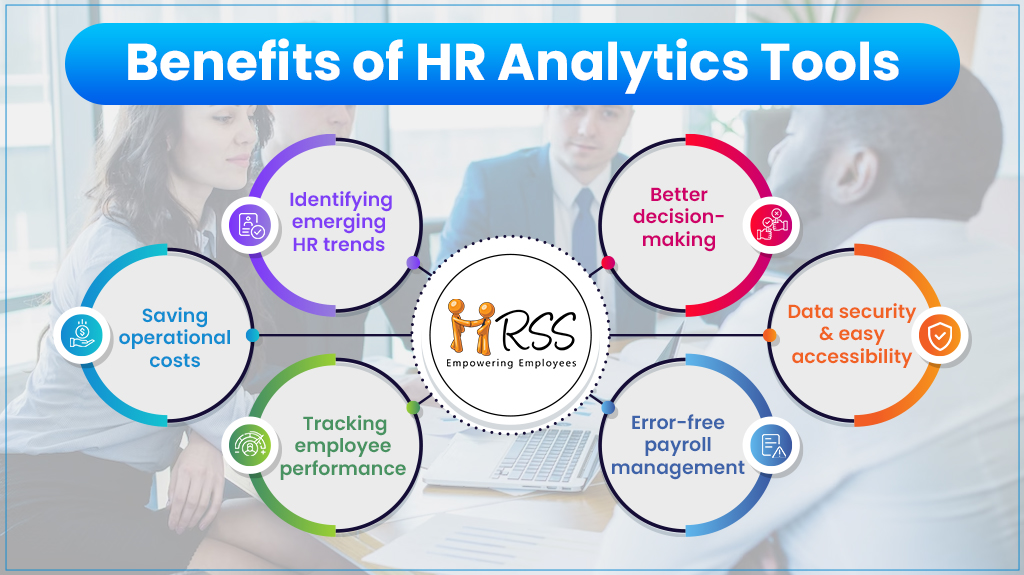Data is the key to a successful enterprise, today. We all know how data is transforming the trade and what power it commands for businesses. Data lets you take informed decisions for future, while helps your HR keep the organization together. Data analytics empowers HR professionals to transform raw data into actionable insights, leading to more strategic and effective human resource management. From recruitment to retention and performance management, the integration of data analytics into HR practices builds a resilient and dynamic workforce.
In this blog, we discuss the modern HRMS with its powerful HR analytics tools with their usage.
What is Predictive HR Analytics?
Organizations use predictive analytics to enhance decision making by identifying key performance indicators and potential areas for improvement. For instance, Google may be using data analytics to refine its hiring processes, identifying the traits that predict employee success. While General Electric (GE) may use workforce analytics to forecast future talent needs and plan accordingly. By analyzing employee data from performance reviews, training outcomes, and project success rates, businesses can tailor development programs to enhance overall productivity
Going by the Gartner definition, “HR analytics (also known as people analytics) is the collection and application of talent data to improve critical talent and business outcomes. Predictive HR analytics enable HR leaders to develop data-driven insights to inform talent decisions, improve workforce processes and promote positive employee experience.”
Data, if used the right way, enables analysis for deeper insights and knowledge on the subject. As Deloitte notes, “77% of executives now rate people analytics as a key priority. In response, companies are building people analytics teams, rapidly replacing legacy systems, and combining separate analytics groups within HR into one strategic function.” This report found that 44% of surveyed companies use workforce data to predict business performance.
We can therefore infer that predictive HR data analytics is the science of gathering, organizing, and analyzing the data related to HR functions like recruitment, talent management, employee engagement, performance, and retention to ensure better decision making by the HR. While the HR departments are generating a large amount of data every day. However, the objective of HR data analytics is to make sense of this data and turn it into a valuable insight. HR analytics software play an important role in converting this mass data to useful HR insights.

Benefits of Predictive HR Analytics Tools
The amount of data flowing into the HR departments over the years is humongous. If unorganized and distributed, it gets very difficult to retrieve or analyze this data.
How convenient it would be if HR professionals could predict which candidates will become top performers, identify and address employee dissatisfaction before it leads to mishap, and tailor training programs to each individual’s unique needs. This is not a futuristic dream but a present reality made possible through data analytics. By leveraging data analytics, HR departments are transforming their functions from administrative support to strategic partners in organizational success.
Here technology is making a huge difference in the HR world. Cloud and analytics have been instrumental in helping analyze information and gain useful insights that help in taking strategic decisions. Cloud-based HR automation technology has now allowed HR teams to transition their analytics processes into services. Besides accessing your data from any part of the world, and anytime you want, here are a few more benefits of predictive HR analytics tools.
- Better decision-making
- Data security & easy accessibility
- Error-free payroll management
- Practicing data-backed HR
- Improving talent acquisition
- Tracking employee performance
- Building equitable compensations and benefits
- Enabling effective workforce planning
- Easily conducting skills gap analyses
- Boosting learning and development
- Improving candidate and employee experience
- Identifying inefficiencies
- Saving operational costs
- Supporting internal mobility
- Identifying emerging HR trends
- Supporting organizational goals
Conclusion
Despite the challenges, organizations are committed towards utilizing the benefits of predictive HR analytics software and use it for long term strategic decision making. Most top performing businesses use data not to make windfall gains but to forecast and plan for future. Using HR analytics tools to analyze the ROI of various programs and initiatives helps make better decisions for company’s future.
Using HR automation tools and automated processes not only reduce data errors due to human factors but also give time for more important strategic tasks. Evolving to HR analytics software is one of the easy ways to utilize the real power of predictive HR analytics.
HRSS360 is a robust HR automation solution that facilitates your HR to collect and utilize the people statistics for data-backed analysis and business growth. While the Payroll Management feature can help in salary calculation and Pay Slip generation, the data generated due to integration with other HR systems, like Attendance Management, Roster Management, Travel and Expense Management, Asset Management, etc can help speed up the process without manual errors.
Connect with our team to understand your HR analytics software requirements.





